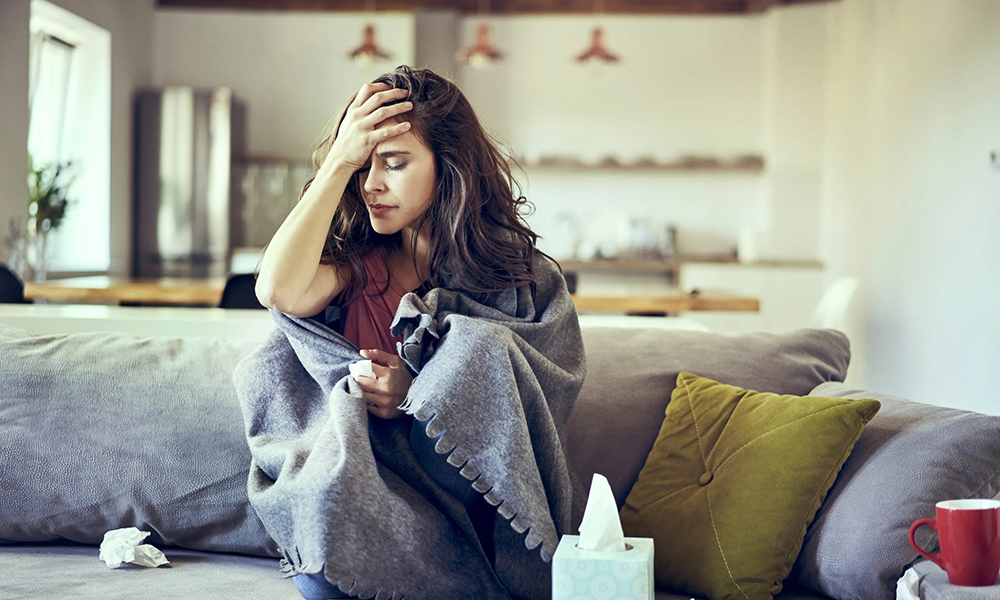
一項最新研究認為,,用于治療新冠肺炎的抗病毒藥物Paxlovid并不是患者出現(xiàn)反彈癥狀的唯一原因,。該研究論文今年10月發(fā)表于《美國醫(yī)學會雜志-網絡版》(JAMA Network),。在這項研究中,超過三分之一未服用過Paxlovid的新冠病毒感染者在初次康復兩天后重新出現(xiàn)癥狀,。
2020年8月至11月期間進行的該項研究,,調查了150多名感染病毒后未服用過Paxlovid的患者(服用了安慰劑)。約一個月后,,68%的患者完全康復,,其中有44%表示在報告零癥狀兩天后再次出現(xiàn)了13種常見新冠癥狀中的至少一種癥狀(例如寒顫、咳嗽,、疲勞,、頭痛、肌肉或身體疼痛,、惡心和嗓子痛等),。
絕大多數(shù)(85%)反復出現(xiàn)癥狀的患者表示癥狀輕微,最常見的癥狀是咳嗽,、疲勞或頭痛,。有15%反復出現(xiàn)癥狀的患者稱至少出現(xiàn)了一種中度癥狀。
論文作者指出:“人們報告的癥狀較為主觀,,我們觀察到的變化可以解釋接受新冠治療之后某些癥狀反復出現(xiàn)的原因,,比如所謂的Paxlovid反彈?!?/p>
由于癥狀反彈效應,,即人們在康復后會再次出現(xiàn)癥狀,因此人們對于治療新冠肺炎的抗病毒藥物Paxlovid存有疑慮,。
研究人員依舊在分析反彈感染現(xiàn)象,,但許多人將其解釋為人們的免疫系統(tǒng)尚無法充分消滅病毒。
三一健康圣瑪麗醫(yī)院(Trinity Health Saint Mary’s Hospital)的傳染病科主任安德魯·詹姆森博士此前曾經告訴《財富》雜志:“人體免疫系統(tǒng)沒有機會同步產生足夠多的抗體,,形成持續(xù)的免疫反應,。”
但專家們依舊在宣傳Paxlovid降低重癥或死亡風險的效果,,這是這種藥物的主要用途,。符合條件的患者、老年人或存在重癥新冠風險的患者,,建議在感染病毒后的五天內服用抗病毒藥物,。
對于未服用Paxlovid的患者,人體的免疫反應依舊可能導致出現(xiàn)反彈感染,,因為每個人對病毒的反應不同,,甚至有患者在短暫康復一兩天后病情加重。密歇根大學(The University of Michigan)的傳染病醫(yī)生普利提·馬拉尼博士對《財富》雜志表示,,老年人出現(xiàn)反彈感染的風險更高,。
她說:“康復并非一條直線,。康復情況與免疫系統(tǒng)對病毒的反應方式有關,?!币虼嗽谑状胃腥竞螅Y狀可能增加也可能減少,。
該項研究在新冠疫苗上市之前進行,,而且當時并沒有出現(xiàn)奧密克戎這種在各社區(qū)表現(xiàn)不同的新變異毒株。因此,,研究結果并未考慮到人們因為接種疫苗而產生的免疫力,,以及人們對不同變異毒株的反應。雖然康復后再次感染令人非常沮喪,,但專家強調有些措施能夠防止重癥,。例如,接種疫苗后出現(xiàn)重癥,、住院和死亡的風險會顯著降低,。(財富中文網)
譯者:劉進龍
審校:汪皓
一項最新研究認為,用于治療新冠肺炎的抗病毒藥物Paxlovid并不是患者出現(xiàn)反彈癥狀的唯一原因,。該研究論文今年10月發(fā)表于《美國醫(yī)學會雜志-網絡版》(JAMA Network),。在這項研究中,超過三分之一未服用過Paxlovid的新冠病毒感染者在初次康復兩天后重新出現(xiàn)癥狀,。
2020年8月至11月期間進行的該項研究,,調查了150多名感染病毒后未服用過Paxlovid的患者(服用了安慰劑)。約一個月后,,68%的患者完全康復,其中有44%表示在報告零癥狀兩天后再次出現(xiàn)了13種常見新冠癥狀中的至少一種癥狀(例如寒顫,、咳嗽,、疲勞、頭痛,、肌肉或身體疼痛,、惡心和嗓子痛等)。
絕大多數(shù)(85%)反復出現(xiàn)癥狀的患者表示癥狀輕微,,最常見的癥狀是咳嗽,、疲勞或頭痛。有15%反復出現(xiàn)癥狀的患者稱至少出現(xiàn)了一種中度癥狀,。
論文作者指出:“人們報告的癥狀較為主觀,,我們觀察到的變化可以解釋接受新冠治療之后某些癥狀反復出現(xiàn)的原因,比如所謂的Paxlovid反彈,?!?/p>
由于癥狀反彈效應,,即人們在康復后會再次出現(xiàn)癥狀,因此人們對于治療新冠肺炎的抗病毒藥物Paxlovid存有疑慮,。
研究人員依舊在分析反彈感染現(xiàn)象,,但許多人將其解釋為人們的免疫系統(tǒng)尚無法充分消滅病毒。
三一健康圣瑪麗醫(yī)院(Trinity Health Saint Mary’s Hospital)的傳染病科主任安德魯·詹姆森博士此前曾經告訴《財富》雜志:“人體免疫系統(tǒng)沒有機會同步產生足夠多的抗體,,形成持續(xù)的免疫反應,。”
但專家們依舊在宣傳Paxlovid降低重癥或死亡風險的效果,,這是這種藥物的主要用途,。符合條件的患者、老年人或存在重癥新冠風險的患者,,建議在感染病毒后的五天內服用抗病毒藥物,。
對于未服用Paxlovid的患者,人體的免疫反應依舊可能導致出現(xiàn)反彈感染,,因為每個人對病毒的反應不同,,甚至有患者在短暫康復一兩天后病情加重。密歇根大學(The University of Michigan)的傳染病醫(yī)生普利提·馬拉尼博士對《財富》雜志表示,,老年人出現(xiàn)反彈感染的風險更高,。
她說:“康復并非一條直線??祻颓闆r與免疫系統(tǒng)對病毒的反應方式有關,。”因此在首次感染后,,癥狀可能增加也可能減少,。
該項研究在新冠疫苗上市之前進行,而且當時并沒有出現(xiàn)奧密克戎這種在各社區(qū)表現(xiàn)不同的新變異毒株,。因此,,研究結果并未考慮到人們因為接種疫苗而產生的免疫力,以及人們對不同變異毒株的反應,。雖然康復后再次感染令人非常沮喪,,但專家強調有些措施能夠防止重癥。例如,,接種疫苗后出現(xiàn)重癥,、住院和死亡的風險會顯著降低。(財富中文網)
譯者:劉進龍
審校:汪皓
Paxlovid, the antiviral drug used to treat COVID, isn’t the only reason you could be experiencing rebound symptoms, a new study suggests. In the study, published in JAMA Network in October, over a third of those infected with COVID who didn’t take Paxlovid still experienced a recurrence of their symptoms two days after their initial recovery.
The study, conducted between August and November of 2020, looked at over 150 people who did not take Paxlovid (they were given a placebo) after contracting the virus. After about a month, 68% recovered fully, and of that group, 44% reported they had recurring symptoms of at least one of 13 common COVID symptoms after two days of reporting zero symptoms (like chills, cough, fatigue, headache, muscle or body pain, nausea and sore throat).
The overwhelming majority (85%) of people with recurring symptoms said they were mild, and most commonly reported cough, fatigue, or a headache. Fifteen percent of those with recurring symptoms reported at least one moderate symptom.
“Reported symptoms are inherently subjective, and our observed variation may explain some of the rebound of symptoms after treatment for COVID-19, like in cases of what has been described as Paxlovid rebound,” the authors write.
People have feared taking Paxlovid, the antiviral treatment for COVID, because of the reported rebound?effect, where people’s symptoms come back after they recover from the illness.
Researchers are still working to understand the rebound infection phenomenon, but many explain it as people’s immune systems not being able to fully fight off the virus yet.
“Your immune system hasn’t really had a chance to catch up and really create enough antibodies to have a sustained response,” Dr. Andrew Jameson, section chief of infectious diseases at Trinity Health Saint Mary’s Hospital, previously told?Fortune.
Still, experts have touted Paxlovid’s ability to curb the risk of getting severely sick or dying from the virus—its main purpose. People who are eligible, those who are older or at risk for developing severe illness from COVID, are recommended to take the antiviral within five days of contracting the virus.
And for people who don’t take Paxlovid, the body’s immune response can still make rebound infection possible—everyone responds to the virus differently, and that includes recovering briefly and getting sicker a couple days later. Older people are more at risk for these rebound infections, Dr. Preeti Malani, an infectious diseases physician at The University of Michigan, tells Fortune.
“Recovery is not a straight line,” she says. “It just has to do with how your immune system takes care of the virus,” so expect symptoms to potentially increase and decrease after initial infection.
The study was conducted prior to the rollout of COVID vaccines, as well as the emergence of new variants like Omicron that have manifested differently across communities. Therefore, the results don’t take into account people’s current immunity from vaccination nor their response to different variants. While the thought of recovering only to get sick again is more than frustrating, experts underscore that there are things that can prevent severe illness. Those vaccinated are at much less risk for severe disease, hospitalization, and death.






